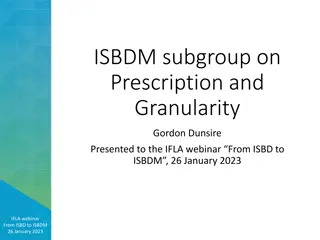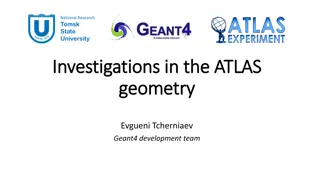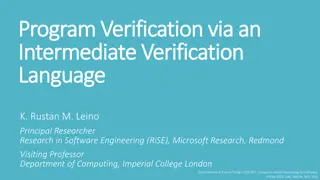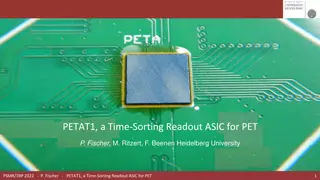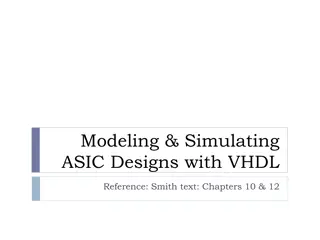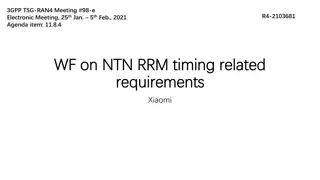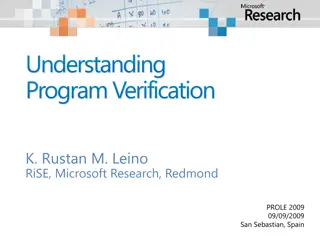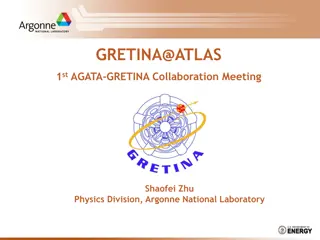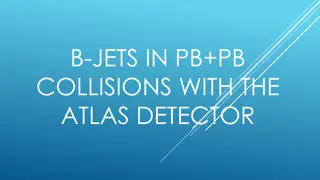Verification Environment for ALTIROC3 ASIC in ATLAS High Granularity Timing Detector
The verification environment for the ALTIROC3 ASIC in the ATLAS High Granularity Timing Detector is crucial for the upgrades in the ATLAS HL-LHC experiment, aiming to improve particle detection performance in the forward region, mitigate pile-up effects, and provide luminosity measurement. The ALTIROC3 specifications include details on chip area, number of pixels, technology, TOA measurement resolution, TOT measurement, power consumption, radiation tolerance, and more. Challenges and methodologies in source code management, clock architecture, analog IP-blocks, and verification strategies are discussed in detail.
Download Presentation

Please find below an Image/Link to download the presentation.
The content on the website is provided AS IS for your information and personal use only. It may not be sold, licensed, or shared on other websites without obtaining consent from the author.If you encounter any issues during the download, it is possible that the publisher has removed the file from their server.
You are allowed to download the files provided on this website for personal or commercial use, subject to the condition that they are used lawfully. All files are the property of their respective owners.
The content on the website is provided AS IS for your information and personal use only. It may not be sold, licensed, or shared on other websites without obtaining consent from the author.
E N D
Presentation Transcript
Verification Environment for ALTIROC3 ASIC of the ATLAS High Granularity Timing Detector Simone Scarf (CERN) on behalf of ATLAS HGTD group simone.scarfi@cern.ch TWEPP23, October 2023
High Granularity Timing Detector for HL-LHC ATLAS HL-LHC HGTD experiment upgrades Integrated luminosity 4000 fb 1 Improve the performance of particle detection in the forward region of the ATLAS detector Pile-up 200 Provide timing resolution of 30 ps per minimum- ionizing particle to mitigate the effects of the pile-up in the forward region Provide a luminosity measurement HGTD Module Posters at TWEPP 2023 Mingjie Zhai HGTD PEB DC/DC Power Block in Low Temperature and Magnetic Field Operation https://indico.cern.ch/event/1255624/contributions/5445331/ Zhenwu Ge An FPGA-based Front-end Module Emulator for the High Granularity Timing Detector Readout Module https://indico.cern.ch/event/1255624/contributions/5445302/ Jie Zhang The Prototype Design of PEB - a Component of the HGTD In-detector Electronics for the ATLAS Phase-II Upgrade https://indico.cern.ch/event/1255624/contributions/5445321/ https://atlas.web.cern.ch/Atlas/GROUPS/PHYSICS/UPGRADE/CERN-LHCC-2020-007/ 2 2
Outline ALTIROC3 requirements and specifications Main projects challenges from a verification point of view: Source code management and IP-blocks versioning Complex clock architecture with several domains Accurate analog IP-blocks models using digital-on-top design methodology More than 1000 configurable registers SEE simulations 3 3
Outline ALTIROC3 requirements and specifications Main projects challenges from a verification point of view: Source code management and IP-blocks versioning Complex clock architecture with several domains Accurate analog IP-blocks models using digital-on-top design methodology More than 1000 configurable registers SEE simulations Examples of verification methodologies adopted 4 4
Altiroc3 specifications Altiroc3 ASIC Chip area 22.5 mm x 20 mm Number of pixels 15 x 15 = 225 Pixel size 1.3 mm x 1.3 mm Technology 130 nm technology 22.5 mm Minimum detectable charge 2 fC TOA measurement resolution 20 ps, range 2.5 ns resolution 40 ps, range 20 ns TOT measurement Luminosityresolution 100 ps, range 25 ns Triggered readout 20 mm configurable transmission rate (320 Mbps, 640 Mbps, 1280 Mbps) configurable protocol (8b10b encoding, raw data) Pixel block diagram Continuous readout fixed transmission rate - 640 Mbps fixed protocol - 6b8b encoding Power consumption 1.2 W (50% digital, 50% analog) Radiation tolerance TID 200 Mrad, SEE robustness 5 5
Source code management and IP-block versioning Main requirements: Same tools in the four different institutions IP-blocks, RTL, scripts version control Each member of the team must be able to: Launch PNR flows Launch full chip simulations Advantages: Easier collaboration Reproducibility of results 6
Multi-site project code organization OA: virtuoso libraries abstract: for digital top integration liberty files: with extracted view in different corners used for digital implementation Analog IP blocks Cliosoft repository OA: virtuoso library liberty files: liberty files for implementation of the top level physical: .def, .lef and .gds files simulation: .v and .sdf files for simulation Digital IP blocks RTL, triplicated RTL UVM testbench Altiroc3 Gitlab repositories Synthesis scripts and PNR scripts Altiroc3_backend 7
Altiroc3 simplified clock architecture clk320M_lpgbt: clk40M_lpgbt: clk40M_INT for digital processing logic (matrix and periphery): Derived from clk320M_lpgbt 40 MHz clock, fully triplicated Skew maximized to spread current peaks over a larger period, minimizing noise Phase set according to clk40M_TDC rising edge to avoid digital current spikes affecting TDC measurement (ensuring always a distance among the two) clk40M_TDC (stop condition for TDC): 40 MHz clock, not triplicated Requires to be aligned with the Bunch Crossing (BC) collision for a TOA measurement with a range of 2.5 ns Very precise skew over all matrix (+- 150 ps) PLL minimizes jitter Coarse shift by 1.56 ns (range 25 ns) Fine shift by 100 ps (range 1.56 ns) with Phase Shifter clk640M: Derived by the PLL Needed for high-frequency output serializers Input clock from LpGBT at 320 MHz Derived from clk320M_lpgbt Used to send out data always in phase clk40M_INT clk40M_TDC clk40M_lpgbt clk640M clk320M_lpgbt 8
Altiroc3 Clock Domain Crossings (CDC) Clock Domain Crossings (CDC): 1. clk40M_TDC - clk40M_INT in each pixel: Data from TDC are sampled with clk40M_TDC and are transmitted to clk40M_INT domain for processing clk40M_TDC and clk40M_int accumulate different delay along the column/matrix, the CDC is checked via Static Timing Analysis (STA) and exact delay is known for all pixels in all corners Clock Domain Crossings 1 clk40M_INT - clk40M_lpgbt in periphery: Data processed in the clk40M_INT domain must be aligned with clk40M_lpgbt domain for output transmission Phase between them is known, custom CDC is used (different sampling edge positive/negative) 2. 3. clk40M_lpgbt - clk640M CDC through a PLL clk40M_INT 2 3 clk40M_TDC clk40M_lpgbt clk640M clk320M_lpgbt 9
Example of data processing Event clk40M_lpgbt clk640M clk40M_TDC clk40M_INT clk40M_lpgbt is in the same domain of clk320M_lpgbt, received by the ASIC clk40M_TDC is set according to Time Of Flight and position of ASIC in the detector, to align within 2.5 ns window around event clk40M_INT is set to ensure a certain distance from clk40M_TDC where digital noise on TDC is minimized clk640M transmits out the data 1. 2. 3. 4. 10
Verification of CDC with Formal Verification (JasperGold) Efficiently identify all CDC at an early stage of the design (RTL level) Debug structural failures (missing synchronizers, structural glitches, convergence/divergence) Generate assertions for running protocol checks during functional verification (e.g.: data stable for N clock cycles, etc) Found Pairs Scheme Analysis Limitation: only checks for structural errors, we still require functional verification 11
Verification of CDC with Functional Verification Only possible when the design is already at an advanced stage (NETLIST level) Ideally, one should develop the UVM testbench having in mind target application: Stimuli: Ability to move hit generation Randomization: Ability to configure internal clock phases in a constrained randomized way Correctness: ASIC can proper sample hits and process data 12
Verification of CDC with Functional Verification Only possible when the design is already at an advanced stage (NETLIST level) Requires accurate Verilog models: Analog Front-End PLL Phase Shifter Ideally, one should develop the UVM testbench having in mind target application: Stimuli: Ability to move hit generation Randomization: Ability to configure internal clock phases in a constrained randomized way Correctness: ASIC can proper sample hits and process data 13
Phase Shifter analog simulation Analog simulations with extracted view Delay of a single delay cell Delay (ps) 97 ps vBias (V) 14 14
Phase Shifter Verilog model Extraction of the model from Virtuoso and modifications of key blocks Delay of a single delay cell Example: Verilog model of a delay cell Delay (ps) 97 ps vBias (V) 15 15
Phase Shifter Verilog model Phase Shifter behavior fully modeled in all corners Phase Shifter delay (analog simulation = Verilog model)) Phase Shifter delay (ps) Phase Shifter fine delay setting 16 16
UVM constrained randomization Constrained randomization: Moving the hit randomization with steps of 100 ps in a range of 25 ns (256 values) Constrain coarse delays and fine delays accordingly. For example, the phase for clk40M_TDC and clk40M_INT following the table: Metrics: 17 17
Summary Altiroc3 for ATLAS HGTD: 20 ps TOA meas. Resolution 40 ps TOT meas. resolution 100 ps luminosity meas. resolution Main verification challenges and solutions: multi-site project complex clock architecture -> increased complexity of verification environment critical analog macros -> development of accurate Verilog models -> efficient source code management and version control Two complementary approaches to verify CDC: formal verification using JasperGold tool -> fast results, early stage (RTL) functional verification using UVM framework -> NETLIST level, check correctness 18 18
UVM framework developed since September 2021 vManager tool to handle randomized simulations and coverage collection Test cases Luminosity data monitor Verify alignment functionality using 6b8b decoding Conversion to human readable output packets Scoreboard Comparison between expected and observed packets Cycle accurate Fast and Slow control dependent Efficiency report Reference Model Ideal behavior of the chip Cycle accurate Fast and Slow control dependent Calculation of expected trigger data Calculation of expected luminosity data Random hit generation Cycle accurate hit generation from real physics events for different transmission rates UVM framework Trigger data monitor Verify alignment functionality using 8b10b decoding Conversion to human readable output packets Slow Control Write and read all registers Perform write and read on illegal addresses Use of chip broadcast Fast command Send all fast commands Send illegal fast commands Realistic trigger distribution Altiroc3: 15x15 pixel matrix measuring TOA, TOT and luminosity SRAM in each pixel PLL and Phase Shifter in periphery Continuous luminosity (hit counters in two configurable windows) data stream Triggered events (BCID and L1ID + pixel information containing hit location, TOA and TOT) data stream DUV 20 20
Hit generation LHC BC Hit injection over 12.5 ns: Charges are injected around the BC posedge over 3.125 ns (number controlled with occupancy) In reality the occupancy can go up to 35%: https://aleopold.web.cern.ch/aleopold/hgtd/hgtd_asic_simul_hitdistros_log/ Few charges injected in the larger window of 12.5 ns to model afterglow effect (at maximum 5% of occupancy) 21 21
Phase Shifter Verilog model Analog simulations to find relationship between voltage bias and delay in ps: 22 22
SystemRDL language The SystemRDL language, supported by the SPIRIT Consortium, was specifically designed to describe and implement a wide variety of control status registers. Using SystemRDL, developers can automatically generate and synchronize register views for specification, hardware design, software development, verification, and documentation. (Wikipedia) Example: 23 23
RDL files hierarchy pixel.rdl column.rdl matrix.rdl 24 24
Flow for I2C registers RDL2verilog RTL wb slave RTL DESIGNER RDL files Modifies only the RDL files. All the other files are automatically derived by the RDL RTL interconnect RDL2csv regs.csv maps.csv blocks.csv QuestaVIP Uses the same RDL used by the designer to generate what is needed for verification VERIFICATION ENGINEER RAL RDL = Register Description Language Documentation: https://systemrdl-compiler.readthedocs.io/en/latest/ UVM register model RAL = Register Abstraction Layer 25 25
RTL TMR: SEU injection results SEU verification strategy: I2C test case Running mode test case I2C test case: I2C operations never fail due to SEU and configuration is never lost in the ASIC Running mode test case has four main categories: Triplicated registers -> No issues Untriplicated registers -> Reduced efficiency, but no synchronization issues Triplicated FIFOs -> No issues Untripliated FIFOs -> Reduced efficiency, but no synchronization issues We can still have issues in PNR due to low distance among registers or simplification SEU run only on digital part of the chip, not on analog blocks 26 26
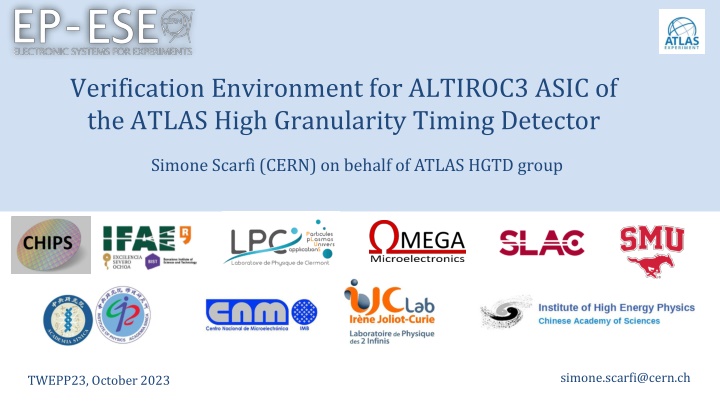

![[PDF⚡READ❤ONLINE] Road Atlas for the Total Solar Eclipse of 2024 - Color Editio](/thumb/21696/pdf-read-online-road-atlas-for-the-total-solar-eclipse-of-2024-color-editio.jpg)

